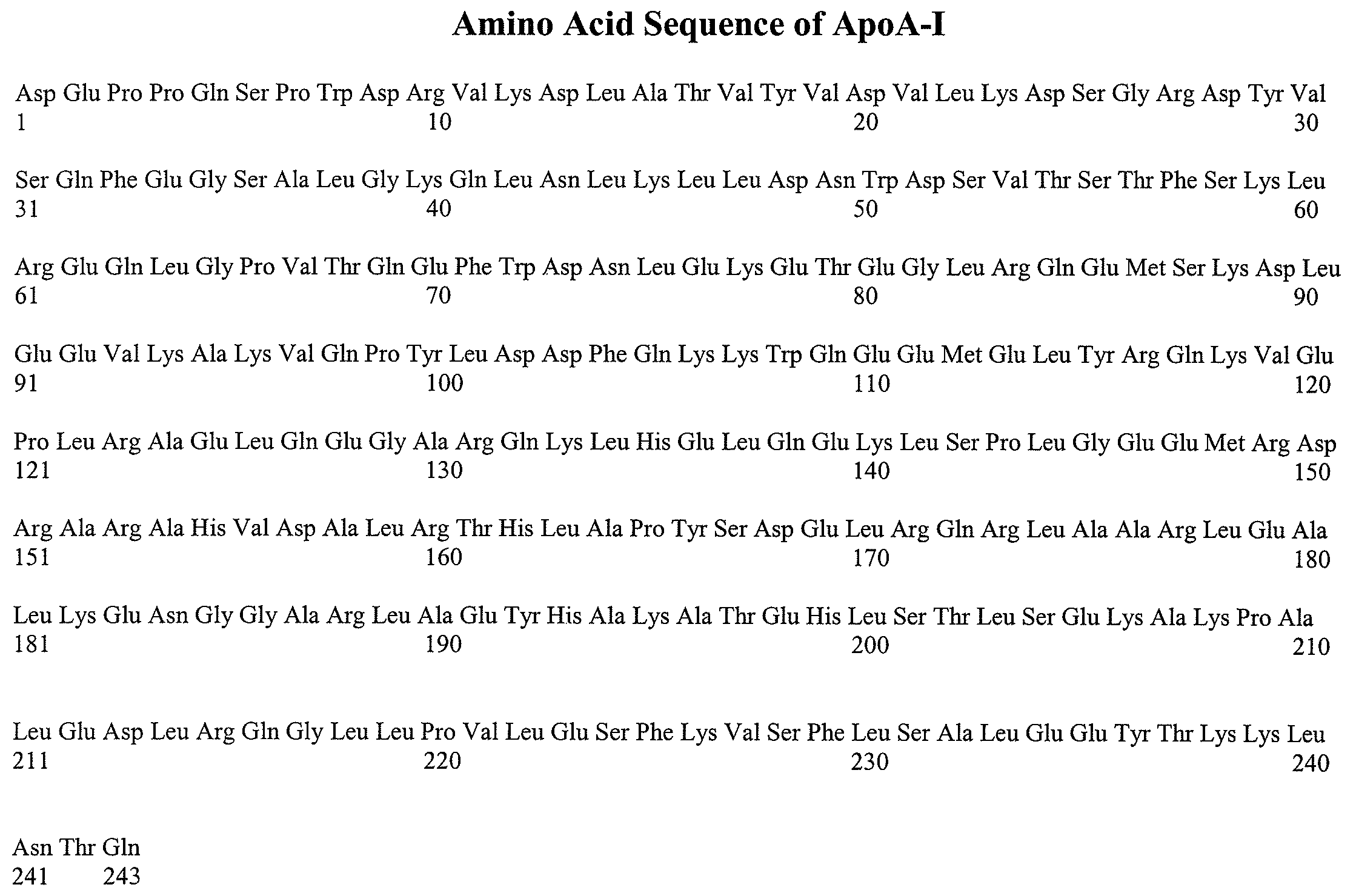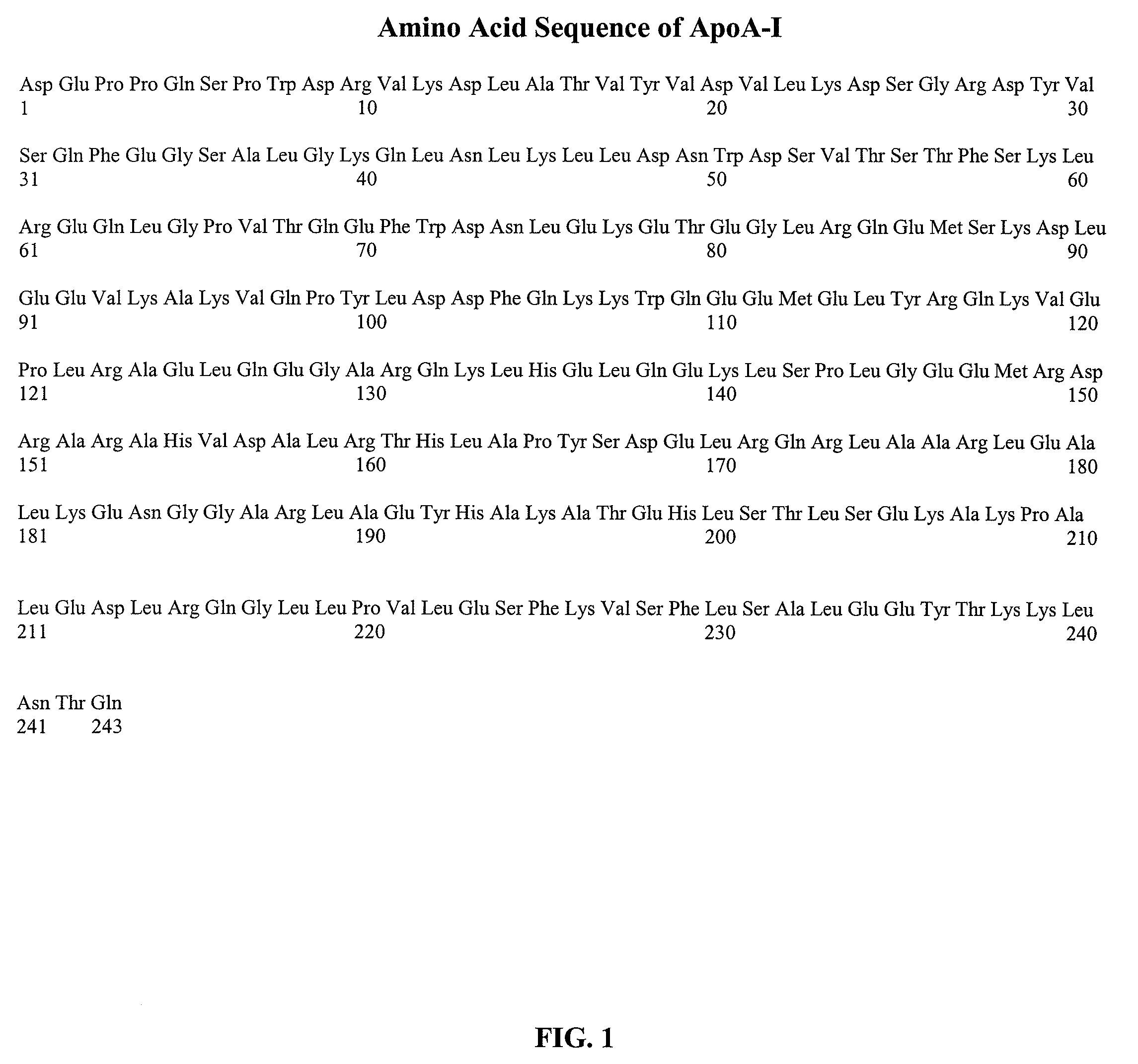Novel Peptides That Promote Lipid Efflux
- Summary
- Abstract
- Description
- Claims
- Application Information
AI Technical Summary
Benefits of technology
Problems solved by technology
Method used
Image
Examples
example 1
Lipid Efflux from Cells Mediated by Peptides of the Present Invention
[0238]This example demonstrates a method to test the ability of peptides of the present invention to efflux lipid from ABCA1-expressing cells.
[0239]HeLa cells stably transfected with human ABCA1 cDNA (ABCA1 cells) and HeLa cells transfected with only a hygromycin-resistant control plasmid (control cells) are produced and grown in a-modified Eagle's medium (aMEM) plus 10% fetal calf serum, as described by Remaley et al. (Biochem. Biophys. Res. Commun. 280:818-823, 2001). Cholesterol and phospholipid efflux is performed for 18 hours on noncholesterol-loaded cells radiolabeled with either cholesterol or choline (Remaley et al., Arterioscler. Thromb. Vasc. Biol. 17:1813-1821, 1997). Percentage efflux is calculated after subtracting the radioactive counts in the blank media (aMEM plus 1 mg / ml of BSA), and expressed as the percent of total radioactive counts removed from the cells during the efflux period.
[0240]Cell fixa...
example 2
Lipid Efflux Time Course
[0243]This example demonstrates the cholesterol efflux time course from ABCA1-expressing cells to apoA-I and peptides of the present invention.
[0244]Cholesterol efflux from ABCA1 cells to apoA-I is first detectable after 2 hours and increases throughout the 30 hour efflux period. In contrast, there is no significant increase above background in cholesterol efflux to apoA-I from control cells. Overall, the kinetics for cholesterol efflux to peptides of the present invention from ABCA1 cells is similar to that of apoA-I, except that cholesterol efflux is first detectable after 30 minutes. In one experiment, SEQ ID NOs: 23, 168, 160, 161, 162, and 163 are tested individually. The peptides of the present invention, unlike apoA-I, also promote cholesterol efflux from control cells but at a lower rate.
example 3
Identification of Non-Cytotoxic Peptides that Promote ABCA1-Dependent Lipid Efflux
[0245]This example illustrates a method for identifying non-cytotoxic peptides that promote ABCA1-dependent lipid efflux from cells.
[0246]The peptides of the present invention promote lipid efflux. These peptides can be produced synthetically or by recombinant DNA methods, as described in the present application, and purified by reverse phase HPLC or other suitable techniques well known to one of skill in the art.
[0247]Peptide Cytotoxicity Testing: Peptides are tested for cytotoxicity by any number of methods well known to one of skill in the art, such as the release of intracellular LDH.
[0248]Peptide ABCA1-specificity for Lipid Efflux: Peptides to be tested are added to serum-free cell culture media in the approximate concentration range of 1-20 micrograms and incubated with a control cell line that does not express the ABCA1 transporter and the same cell line after transfection with human cDNA for th...
PUM
| Property | Measurement | Unit |
|---|---|---|
| Composition | aaaaa | aaaaa |
Abstract
Description
Claims
Application Information
 Login to View More
Login to View More - R&D
- Intellectual Property
- Life Sciences
- Materials
- Tech Scout
- Unparalleled Data Quality
- Higher Quality Content
- 60% Fewer Hallucinations
Browse by: Latest US Patents, China's latest patents, Technical Efficacy Thesaurus, Application Domain, Technology Topic, Popular Technical Reports.
© 2025 PatSnap. All rights reserved.Legal|Privacy policy|Modern Slavery Act Transparency Statement|Sitemap|About US| Contact US: help@patsnap.com



